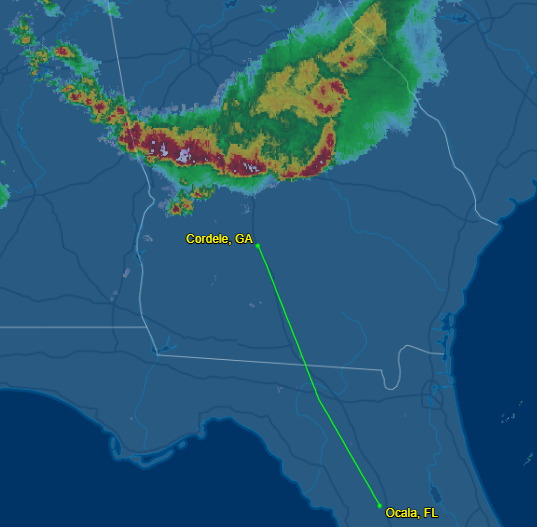On Saturday July 21st I launched in my PA24 180 horsepower Piper Comanche from Jim Taylor field with the intent of flying to Oshkosh Wisconsin with a few stops in between. The first leg of the flight would take me from Ocala to Carrollton Georgia, west of Atlanta, for a quick rest and refuel.
A check of the weather showed a line of under developed storms spread out across the southeasterly moving cold front. The gaps between the storms was wide and the cells were not really generating much as of yet. As we continued to the northwest I kept an eye on the line of storms, so I could pick a gap to pass through them. However as the morning went on, the gaps closed and the few storms combined into a solid squall line.
A squall line is a line of thunderstorms that form at or about the front edge of a cold front. They tend to include very strong rain, hail, lots of lightning, and a phenomenon know as straight-line winds. A straight-line wind acts much like a plow blade and come down and out in front of the storms at tremendous speed and force. For a small airplane like mine this meant almost certain destruction if I was caught aloft in these winds.
Calculating the speed at which the storm was moving towards me, combined with my forward speed, I found the Crisp County Cordele airport (KCF) to be a good spot to set down. I pushed the throttle in a bit and accelerated the plane forward. It would certainly be better to be on the ground and under cover when this line of storms passed over.
We approached Cordele and I called the airport radio and requested a spot under cover. I could see the purple tops, which made me worry about hail damage. The airport FBO attendant was very accommodating and offered an open T-Hangar close to the main building. We landed just ahead of the storm by maybe five minutes. The sky to the north was full of black clouds rippled and engorged with moisture. We got the plane on the ground, installed the gust locks, pushed into a T-hangar next to the FBO, and strapped it down. Just about then the wall of water appeared at the far side of the airport. It was closing fast. I snapped this picture just before we ran inside.
 As can be seen from the photo the sky went dark, as if the sun had gone down. It was about ten o’clock in the morning, yet it felt like late in the evening. We borrowed the crew car and went into town to get a few supplies and ride out the storm. We stopped at a local Wal-Mart for some camping essentials and did a quick video.
As can be seen from the photo the sky went dark, as if the sun had gone down. It was about ten o’clock in the morning, yet it felt like late in the evening. We borrowed the crew car and went into town to get a few supplies and ride out the storm. We stopped at a local Wal-Mart for some camping essentials and did a quick video.
The storm blew with a mighty fury for about an hour and dumped lots of rain. Overall this was a good decision to stop and wait it out. The squall line is by far the most deadly and dangerous weather for our little planes. My best unsolicited advice is to never ever fly though a squall line. Instead get on the ground before the storm and wait it out. Let the storm pass, wait a bit longer until the skies clear up and then continue.


